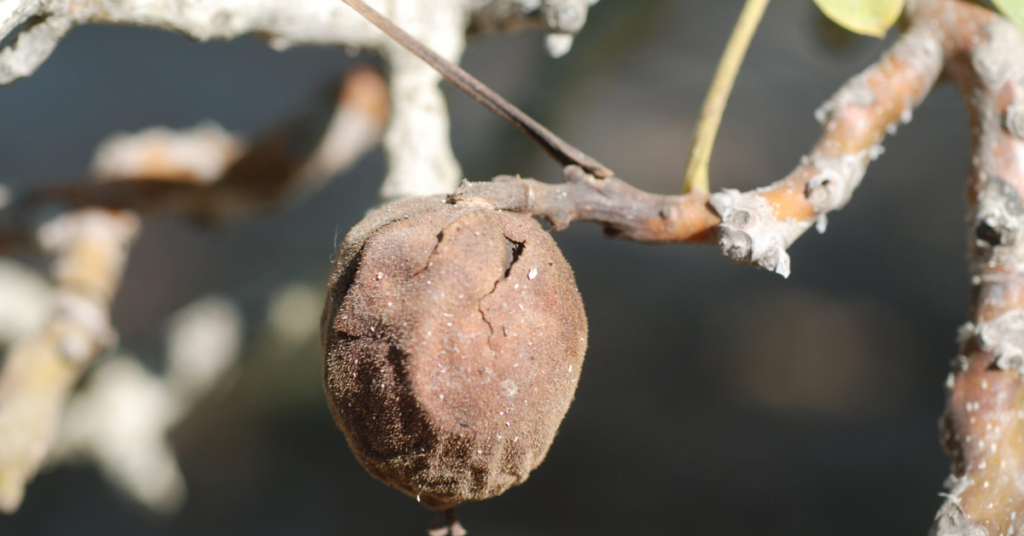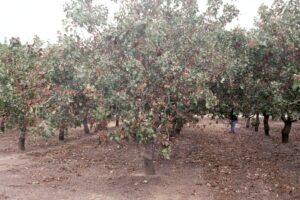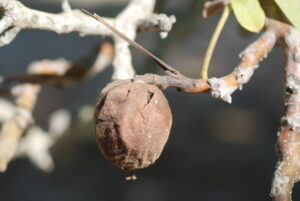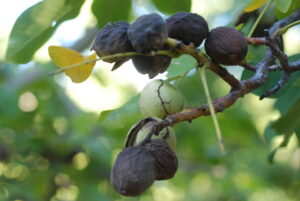
March/April 2024
The Blight Phase of Botryosphaeria diseases in nut crops of California
Diseases caused by fungi members in the family of Botryosphaeriaceae (Bot) are characterized mainly by the development of cankers. These fungi attack shoots, branches, scaffolds and trunks of trees causing killing of the plant tissues and forming a canker.
Botryosphaeriaceae fungi are also known for decaying tropical and subtropical fruit by infecting them in the field as latent infections and developing in postharvest storage of these fruit. However, diseases caused by Botryosphaeriaceae are not well known causing active fruit blight (killing), which is associated with severe yield losses. Before referring to specific examples, let us define what is a blight and what is canker.
A blight is the killing of entire vegetative or fruiting plant tissues without the necessity of the pathogen to colonize all the blighted tissues. A blight can result in the development of a canker.
Referring to trees, a canker is a continuous mass of killed tissues in trunks, scaffolds, branches and shoots where the canker pathogens has grown and colonized the entire cankered tissues and beyond. A canker can result in the development of a blight. However, a blight does not need a canker to occur.
Two good examples of disease representing a canker and a blight phases are the Botryosphaeria panicle and hoot blight of pistachio and the Botryosphaeria canker and blight of walnut.
Botryosphaeria panicle
Botryosphaeria panicle and shoot blight is caused by 10 members of the Botryosphaeriaceae fungal family. All these fungi produce pycnidia, flask-like structures that contain the spores of these fungi. The spores, otherwise called pycnidiospores, spread by water (water-splashed) and infect all the current growth green tissues.

During the fall and winter, these spores fall on dormant vegetative and flower buds and are trapped among the basal bud scales. Under conducing conditions, the first blighted structure is entire blighted leaves from infections at the base of the petiole, or blighted leaflets that can defoliate as well. Another early blighted tissue can be the young panicles, only if the temperatures are warm in the spring.
Infections at the base of young developing shoots from contaminated buds turn black resulting in leaf wilting, and the blight of the entire shoot. These shoots retain their killed leaves which will turn to bright brown color very distinct among the green, healthy foliage. In years with severe disease, multiple blighted shoots can develop per tree. But the most devastating blight phase of the disease is the panicle blight (the killing of the fruit clusters).
The blighting of the pistachio cluster can occur either from infection of bud or latent infection of the fruit. Infection of the fruiting bud can lead to girdling of the cluster since the infection will develop at the rachis (main stem) base, and it is usually very quick (one week). In contrast, fruit latent infections will develop during summer and will blight the fruit. The infection from the fruit will move into the rachis to kill either part of the cluster or the entire cluster, depending when the latent infection was triggered to express disease symptoms.

The blighted rachis and the cankers play a significant role in the life cycle of the pathogen and the disease because portions of these tissues are covered with pycnidia of the pathogen surviving on to the trees. If a late rain in the season occurs and temperatures are still above 68 °F, flower buds which were set in June/July can get infected and become blighted entirely or partially.
In addition to yearly yield losses due to blighted clusters, blighted buds contribute to losses of the next year’s crop. Once the blighted shoots, clusters, and buds develop, it is too late to control the disease. However, protecting the green tissues from latent infections in the spring can control the disease significantly. Sprays are done starting at bloom and finish by the end of July; sprays in August and/or later are not effective. If a grower has low pressure of the disease and desires to do a fungicide application, the best timing would be the first part of June.
Botryosphaeria canker and blight of walnut
A second disease that also causes blights and cankers is the Botryosphaeria canker and blight of walnut. This disease has many similarities with the pistachio panicle and shoot blight. The blight phase of the walnut Bot disease results in the blight of the fruit (it was the fruit cluster in the pistachio).

The disease starts as latent infection of green fruit in the spring. Symptoms and disease progression will start developing in the summer as the fruit starts maturing. The blight from one fruit will move to one to two neighboring fruit, which will also blight and then from the peduncle the infection will move into the spur and from that spurinto the shoot and cause a canker.
The result of this canker, and depending on how far the canker will move, is the killing of the next season’s flower and vegetative buds. Therefore, the Bot of walnut will blight part of the season’s fruit and at the same time will reduce yields of the subsequent season by killing the flower and vegetative buds. Depending on the environmental conditions and the extent of infection, the pathogen can also enter from the blighted spur into last year’s wood and cause large cankers.
In walnuts, because the wood is softer than that of pistachio, the entire surface of the cankered tissues will be covered with pycnidia, which are the fruiting structures of the Bot fungi. In walnut but not found in pistachio, some of these species will also develop pseudothecia in some areas of the canker along with areas with numerous pycnidia. Pseudothecia contain sack (asci) with eight ascospores each, which when there is rain these structures will swell, increasing the pressure in the pseudothecium and the asci that will shout the spores (ascospores) in the air.
In contrast with the Bot disease of pistachio, for Bot of walnut there are two types of inoculum that overwinter on the trees and/or the ground in pruned shoots and branches left in the orchard. For both diseases, the cankers extend internally in the tissues about 2 inches beyond the external margins of the canker.
When suggestions are given to growers to prune the cankers and reduce inoculum in the orchard, the recommendation is always to prune about 2 to 3 inches beyond the external canker margin.
Particularly in walnuts, pruning wounds are very susceptible to infection by Botryosphaeria fungi in contrast to pruning wounds of pistachio. In walnuts, the shoots have a central channel which is filled with loose pith. When it rains, the pith acts as a sponge absorbing and holding the water longer, thus giving a chance for the spores that have landed on the pruning wound to germinate and establish an infection.
Using artificial inoculation experiments, we showed that pruning wounds of walnut can remain susceptible to infection for at least four months. In addition, the presence of walnut scale (Quadiaspidiotus juglandis) weakens the shoot and infections occur more frequently, resulting in blighted shoots and branches. Also in walnuts, lower limbs that are shaded eventually die, are colonized by walnut scale and covered with Botryosphaeria fungi.
This is because the Botryosphaeria fungi also exhibit an endophytic phase. An endophyte, according to the definition of the American Phytopathological Society, is a close association and reproduction of the fungus and the host tissues, without the expression of any disease symptoms (lesion, blight or canker).
Control of Bot of walnut is achieved with pruning major branches to reduce inoculum, and fungicide sprays starting in mid-May, mid-June, and mid-July. Sprays applied after late July are not effective (http://ipm.ucanr.edu/PDF/PMG/ fungicideefficacytiming.pdf). Sprays applied just before and during early hull split are effective in reducing mold of walnuts, which is caused mainly by Alternaria and Fusarium spp.
In orchards where Bot canker and blight occurs, part of the walnut mold is caused by Botryosphaeria. The blight phase of Bot diseases can cause more yield reduction than the canker phase. Therefore, growers need to preventatively protect plant tissues from infections occurring.







